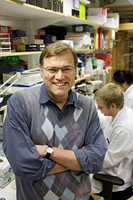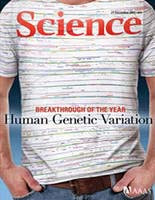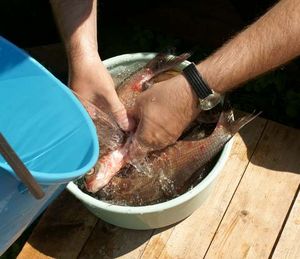Leif Groop

Fishing with larger and larger trawls, but with a smaller and smaller mesh
The phone rang, interrupting him while cleaning some newly caught fish. It was Eric Lander, calling from Boston. "Would you like to do some real fishing instead?" he asked. And that was the start. Leif Groop said yes and today, nearly 20 years later, he is one of the most successful diabetes researchers in the world. And not unexpectedly, gene fishing is his speciality.
Shortly after Landers phone call Leif Groop was in Boston fishing for diabetes risk genes. This was in 1991-1992, and the genetic research field was still very young. "Essentially, it didn’t pay off at all. We wanted to do so much more than we could", Leif Groop says, "The technology available at that time was powerless". Still, this was the first test of what would become the main direction of his research career– unraveling the genetics of type 2 diabetes.
Waste of time
A lot of people felt that Leif Groop was wasting his time. The problem was too complex and in addition not very important. "People thought type 2 diabetes was uninteresting. Or even worse, simply something your old aunt would get in her late years. Nothing to fuzz about."
The occasional urine test
His interest in diabetes started during his first job working as a doctor in Närpes, a small town in western Finland, in the beginning of the seventies.
"Diabetes care was really bad in Närpes, in Finland and all over the world. Patients were lining up with their urine samples. We told them to change their eating habits and perhaps prescribed them some pills. But since we only had the occasional glucose test to use for evaluation we did not really know what happened to them."
Importance of heredity
"The role of heredity in type 2 diabetes was unknown but unquestionable. More than half of all diabetes patients have a family member who also has diabetes. The heritability was obvious and that is important", says Leif Groop.
An interest in genetics was the reason that Eric Landers call went to Leif Groop, one of few scientists focusing on the genetics of complex diseases such as type 2 diabetes.
Finland’s first diabetes nurse
Back to Närpes and the poor diabetes care. Leif Groop had heard about a care center in Sweden, in Dalby outside of Lund, where a nurse named Madeleine Svensson was teaching diabetic patients to take care of their disease themselves. The rumor was confirmed and in 1974, Leif Groop and Monika Söderback, a nurse from Närpes, made an educational visit to Dalby. Soon, Finland had its first diabetes nurse.
"The diabetes care improved dramatically", Leif Groop says and tells about a widower who lived alone, who had diabetes and very bad blood sugar levels.
"One day he came back with almost normal blood sugar. I couldn’t figure out what had happened but Monika could. She had made a house call and taught the old man to cook two new dishes to complement the sausage he had been eating every day."
Unethical to lend out glucose meters
"After that it was one novelty after the other in Närpes. One was that diabetes patients could borrow a glucose meter for a few days. I was actually criticized for that at a national meeting for medical doctors. An elderly doctor said that it was unethical to lend out the meters, that we were shifting the responsibility to the patient. A few years later, including the patient in the process was a matter of course, not only in Närpes. The authoritative approach to care was being replaced."
Complex disease panorama
It was more and more obvious to Leif Groop that the traditional division of diabetes into two distinct types, type 1 and type 2, was too simplified. "It didn’t add up. We could clearly see that there were patients who had mixed and intermediary types", he says and adds: "It is important to be curious and inquisitive, and not to blindly believe in dogma. Very few dogmas survive and it is the duty of science to break them."
Rather a journalist than a doctor
Working in the local health service in Närpes was a commitment Leif Groop had to fulfill after completing his medical training in Switzerland.
"Finland, which was poor after the war, had an agreement with Switzerland that they would educate 25 physicians per year for 10 years", says Leif Groop and admits that going abroad was more attractive than the medical education.
"Traveling to another country was tempting but I didn’t really want to be a doctor. I wanted to be a journalist. Medical school was just an excuse to get to go abroad", Leif Groop comments. He had already had assignments for Vasabladet both as a writing journalist and as a photographer.
Bern-Närpes-Helsingfors-Yale University
Following his studies in Bern in Switzerland and his years as a general practitioner in Närpes in Finland the Groop family moved to Helsinki. Leif Groop worked as a specialist in internal medicine at Helsinki University Central Hospital and as a scientist.
He presented his thesis in 1982 and not surprisingly it was about the differences between different types of diabetes. "Yes, I was already on the track I have followed ever since and I had great support from Risto Pelkonen who is now the Finnish archiator. He was influential and also an inspiring mentor", says Leif Groop. His thesis was followed by more research, including two years (1984-1986) at Yale University in the US, and then back to Helsinki.
Described a hybrid type
The old skepticism also showed in 1986 when Leif Groop and Tiinamaija Tuomi, associate professor in Helsinki, described a new type of diabetes, a hybrid type, LADA, which is an autoimmune disease, just like type 1 diabetes, but is milder and strikes later in life. "Back then people shook their heads and dismissed LADA as a theoretical construction. But the description was important and opened up new research areas", says Leif Groop. Today, LADA is an established concept and has turned out to be the second largest group of diabetics, even more common than type 1 diabetes.
New professor in Malmö
In 1990 the Botnia study started. It is a family based study in western Finland that currently includes more than 9000 individuals, possibly making it the largest of its kind in the world. One of the objectives is to map out the genetics of the different types of diabetes. Leif Groop is the head of study and Närpes is one of the towns that have been included from the start. After four years the Botnia study was expanded to include all of Finland, as well as southern Sweden. By then Leif Groop had been active in Malmö for a year.
Finnish scientists came along
He had been offered the position as professor in diabetes and endocrinology in Malmö.
"When I told my family, the dog was the only one wagging its tail", he states. The family stayed in Finland another two years until his two sons had finished school and moved out. Leif Groop commuted and worked hard to create diabetes research worthy of the name in Malmö.
"Basically, there was none. A crucial factor for getting started so fast was that I had eight people who came along from Finland", he says. Three of them remain in Malmö, Leif Groop, the scientist Marju Orho-Melander and the laboratory engineer Esa Laurila.
Worked in three shifts
A lot of Finnish was heard in the corridors of the Wallenberg laboratory in the beginning and the group worked hard on a new study looking for risk genes for type 2 diabetes.
"I was convinced that the way to better understanding of the diabetic diseases, and better treatments, was through more in depth genetic knowledge about the disease mechanisms", Leif Groop explains.
The mapping included 217 individuals for whom 387 markers were analyzed. Three laboratories worked on the study for ten months; in the end in three shifts.
"It was tough and by today’s standards far from adequate but still a first step. The results were published in 1996 in the journal Nature Genetics."

Different possibilities today
Eleven years later, 2007, another very large mapping was published in Science. Now, Leif Groop and the other scientists have access to a completely different set of tools that allows gene fishing on a much larger scale. The Science study included 500,000 markers analyzed in 3,000 individuals.
Three new unexpected genes for type 2 diabetes and one for blood lipids were caught in the net. Leif Groop was one of the initiators of the study. The total number of authors was more than 60.
"This type of research is very technology driven. The possibilities are completely different today than only a few years back so now our knowledge is increasing at a very high speed", says Leif Groop.
Collaborations and networking
When the Science article was published he had been the coordinator of LUDC (Lund University Diabetes Centre) for a year; a consortium made up of approximately 150 scientists and the number is constantly growing, making it one of the largest in the world. The main language is no longer Finnish but English, and the number of nationalities at LUDC is more than 40.
LUDC also collaborates with other universities and consortia. "I believe in collaboration, in building networks. Top-level research today is so large scale, you need to have both the competence and the resources to succeed", says Leif Groop who is the head of several large collaboration projects.
Long days at high speed
Leif Groop has achieved more than most scientists, probably more than most dare to dream about. He has made impressions, is internationally recognized and has published more than 500 scientific articles. The price is a work week of 50-60, sometimes more, hours at a high tempo. Why does he work so hard? He could retire with satisfaction.
"I work that much because there is so much to do, is the natural answer."
He basically works even when he is free. Sometimes he reads about a problem before he goes jogging.
"Yes, and after a while your thoughts go the problem automatically. It also happens if you read before you go to sleep. Science is a full time occupation. It is not something you can do only occasionally."

It will be some sort of fishing
Leif Groop continues to work as a diabetes doctor in parallel with the research.
"I enjoy it and it is what I was trained to do. In addition, the most important questions have sprung from meetings with patients. I think it is difficult to do research on diabetes without seeing diabetes", he explains.
How about retirement then? It really is not that far away. What will he do then?
"Well…", the answer is a bit hesitant, "read something other than scientific articles, maybe write a book about something that fascinates or annoys me. And keep fishing, real fish", he says.
And who knows, maybe the phone will ring when he is cleaning his new catch.
Text: Tord Ajanki/Emma Ahlqvist
Photo: Kenneth Ruona and Konstantin Milenin/Dreamstime